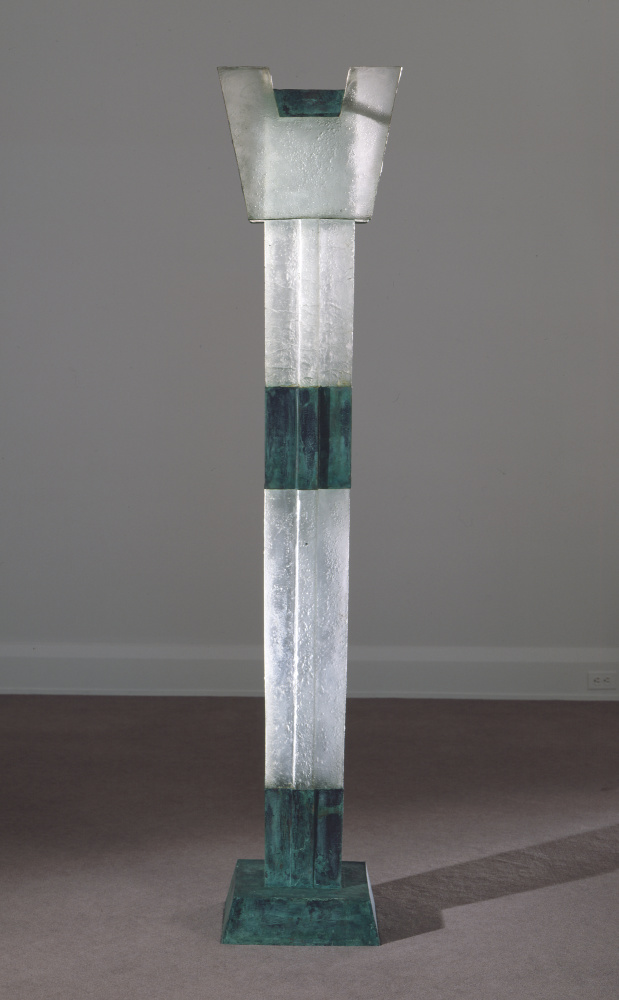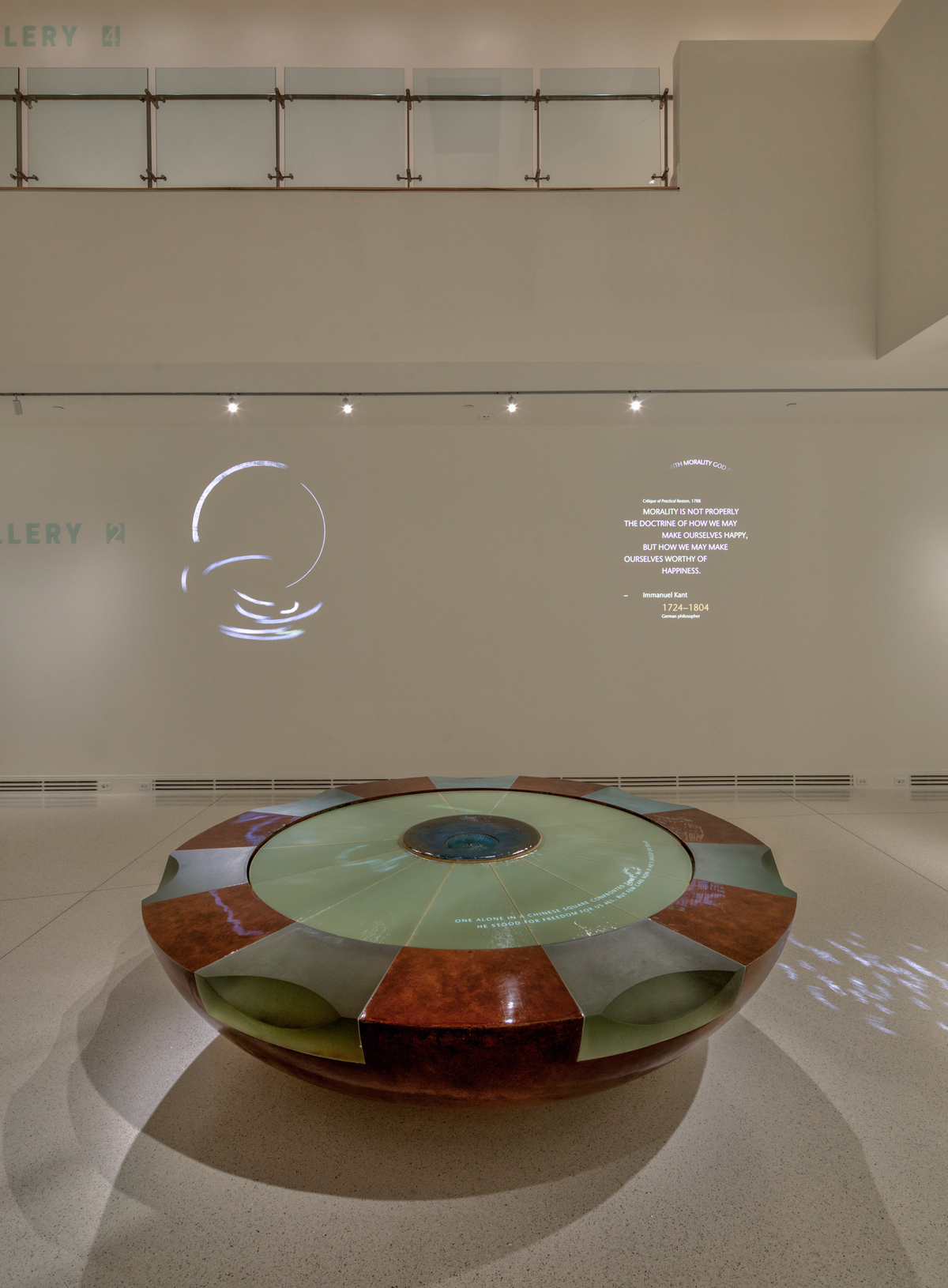- Closed today. View hours.
- Parking & Directions
- Free Admission
In Memoriam: Howard Ben Tré (1949–2020)

Howard Ben Tré (American, 1949–2020), Column 20, 1984, Cast glass and patinated copper, Museum purchase and anonymous gift, dedicated by the Trustees to Richard F. Barry III in gratitude for his long and distinguished service to the Chrysler, June 2004, 92.13
We are deeply saddened to learn of the recent passing of Howard Ben Tré. He was 71 years old. Celebrated for his massive cast sculptures of luminous sea-green and colorless glass that were typically combined with metal or stone, Ben Tré was a pioneer in the use of cast glass as a sculptural medium and a master of form. His artworks are widely approachable for their simplicity and serenity, which belie their conceptual underpinning and technical virtuosity. Ben Tré’s body of work notably includes site-oriented public artworks that are frequently in the form of fountains and benches and made of a strong industrial glass that can survive the rigors of outdoor installation.
Ben Tré began working with glass in his late 20s, moving to Providence to attend Rhode Island School of Design (RISD) for his Master of Fine Arts and establishing his studio in nearby Pawtucket after graduation. RISD is where Ben Tré discovered glass as an artistic medium, but it was his four years of education at an industrial high school in Brooklyn that gave him the skills to go in new directions with his glass sculpture. Classes in foundry practice, machine shop, architectural drafting, and pattern making would all later help him realize his unique ideas in glass. His process of casting large-scale work was adapted from working in bronze. At RISD, Ben Tré recalled that as he looked into the glass furnace he thought, “This is liquid. It can be poured like a metal.” The artist also remembered, “When I first started working with glass, people said ‘you can’t do that,’ and I said ‘why not?’”
Beginning with the sketch of an idea, Ben Tré would draft a preparatory drawing and create a full-scale mockup using dense foam. A resin-bonded sand mold captured the negative shape of the foam sculpture and was taken to an industrial glass factory, where hot glass was stream-fed into the mold. After pouring, the glass cooled slowly in the annealing oven for two and a half months. It was then shipped back to Ben Tré’s Pawtucket studio for finishing. Freed from its mold, the solid glass sculpture was sandblasted, cut, and ground into its final shape and assembled from parts. Ben Tré combined his glass sculptures with smaller elements of copper, lead, bronze, and other metals or stone as a way to add color and density to his sculptures.
The Chrysler Museum of Art’s Column 20 (1984) is an early example from Howard Ben Tré’s forty-five-year career. The dense pale blue-green glass of the sculpture is made luminous as light diffuses into the glass, making the sculpture appear to glow from within. The textured surface is a testimony to the casting process. The seven-foot tall vertical form is segmented by three sections of copper metal that has a cool, green, patinated surface. Column 20’s shape and stature evokes the architectural language of posts and columns, which is a hallmark of Ben Tré’s work.
Howard Ben Tré liked to say that he was an artist on both sides of his brain: an engineer on one side and a poet on the other, with both sides working together. The engineering side is evident in the planning and execution of such monumental glass sculptures. The poetic side is apparent in the harmony achieved between form, light, and color. The industrial qualities of Ben Tré’s artworks are balanced with their organic qualities; for example, the air bubbles that are released from the binder of the sand mold during the casting process become trapped in the hot glass, imparting a weightlessness and floating sensation to the cooled solid mass that simultaneously evokes both air and water.
In one interview, Ben Tré expressed a wish that people would spend time looking at his work and experiencing it without the distraction of text-heavy explanatory labels. He felt there was something archetypal or elemental in his pieces that tapped into a universal commonality. He believed that a person might not know exactly what it is, but they would know that it touches them.
Ben Tré’s minimalist forms may, in turn, feel industrial, futuristic, and ancient. His sculptures are inspired by elements of architecture and industry, but they also transcend time and place. Columns, stone fragments, monoliths, and machine parts are all elements of the artist’s intellectual and visual vocabulary and Ben Tré was drawn to monumental icons of human creation—Minoan palaces, Mayan ruins, Shinto temples, Gothic cathedrals—the structural pieces of which he sought to interpret rather than appropriate. He understood architectural elements to be expressions of ritual, radiating a mysterious and powerful presence, which he harnessed with luminous cast glass.
Howard Ben Tré is a familiar and beloved name for many living in Norfolk. In 1997, five years after the Chrysler Museum purchased Column 20 with the help of an anonymous donor, Ben Tré was invited to give a lecture in Norfolk by the Chrysler Glass Associates. In 2004, Column 20 was dedicated by the Trustees to Richard F. Barry III in gratitude for his long and distinguished service to the Chrysler Museum of Art. In 2018, the Barry Art Museum at Old Dominion University permanently installed a beautiful example of the artist’s public works, Fountain of Inspiration (2001–2002), which was originally commissioned for a library in Boston.

View of the Barry Art Museum’s Hall of Ideas with Fountain of Inspiration
Howard Ben Tré (American, 1949–2020), Fountain of Inspiration. Fountain design and fabrication cast glass, laminated glass and bronze, 2001–2002
David Small (American, b. 1965), Hall of Ideas. Digital design and projection; The Mary Baker Eddy Library (Est. Boston, 2001), original compilation of quotes, 2001
Gift of the Bleakhorn Foundation to the Barry Art Museum 2017.133
John Wadsworth Photography
Howard Ben Tré’s desire to make art that brings people together in our collective humanity makes his passing all the more poignant during a time of such extreme social upheaval due to a global pandemic. Because of current social-distancing requirements at the cemetery, his ashes were placed during a small three-person ceremony. Ben Tré’s widow, Wendy MacGaw, is planning a celebration of her husband’s life in the spring when one of his glass sculptures will be unveiled as his grave marker. It will be a bench, she says, and “anybody who sees it will know exactly who’s buried there.”
– Carolyn Swan Needell, PhD, Carolyn and Richard Barry Curator of Glass

